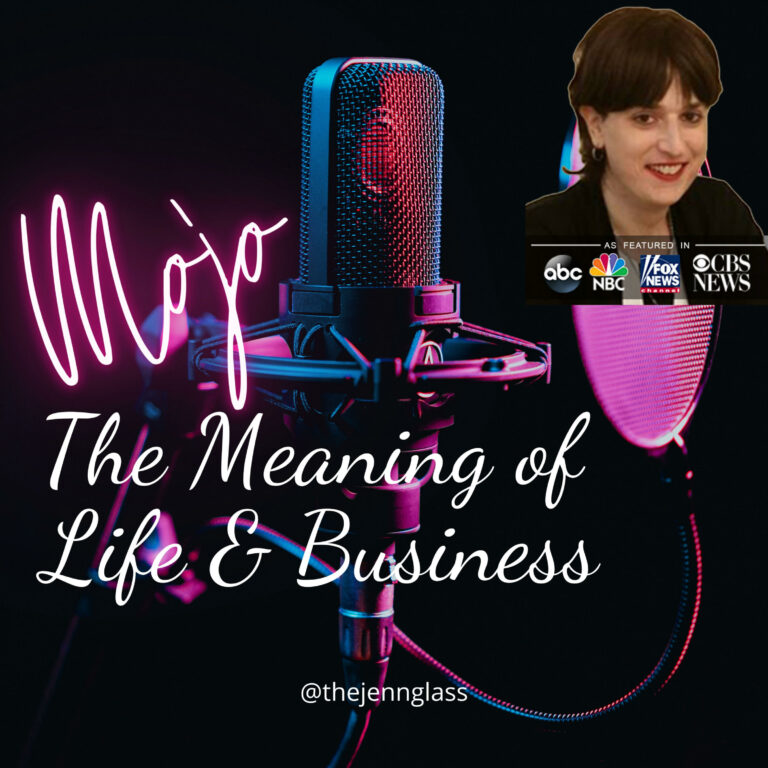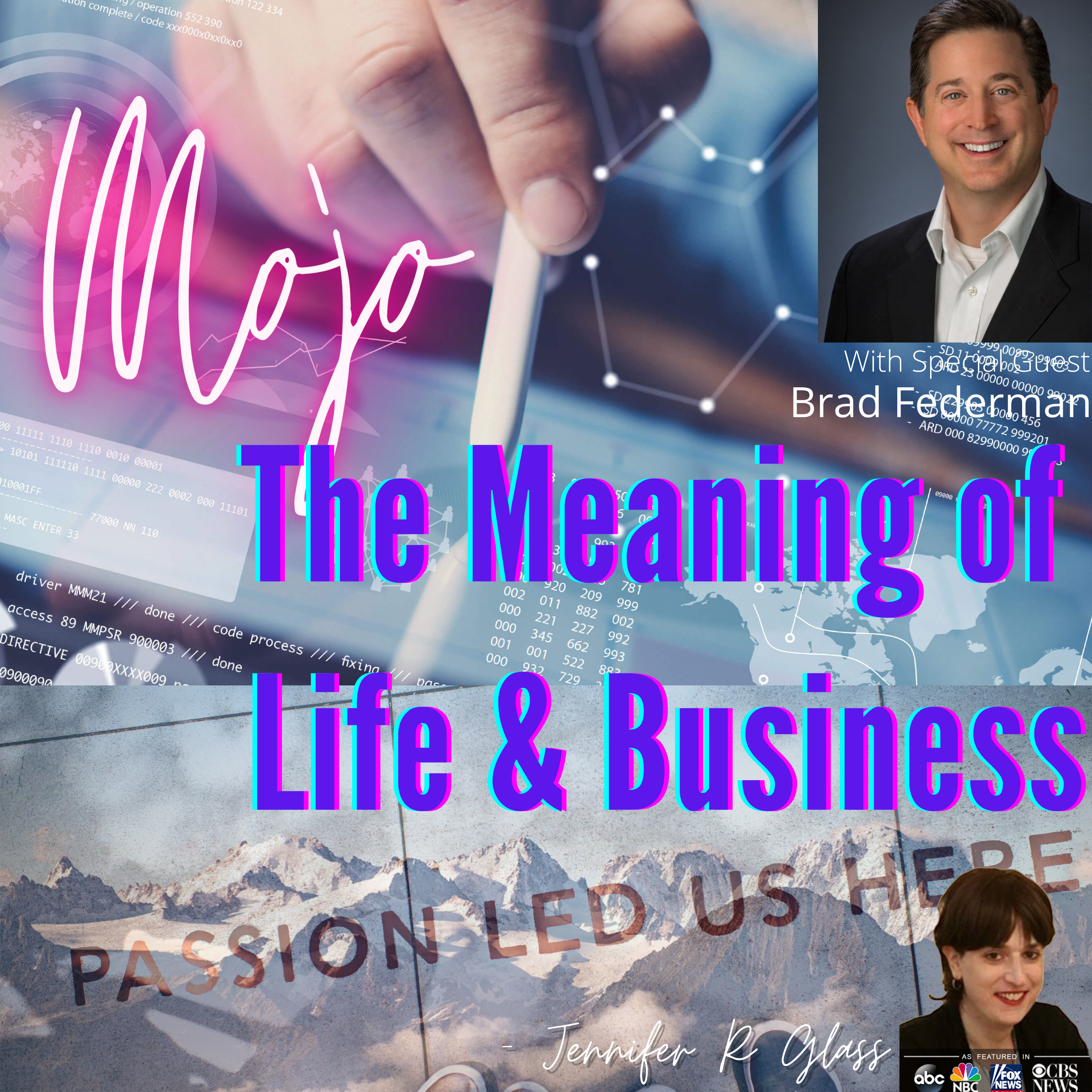What does it mean to be a leader and how do you become a good leader for your business?
In this episode, we talk about leadership and what you need to do when creating teams, how-to guide them, and how to make your company work for your customers. As my guest puts it, you have to engage your employees or your team to better focus on your customers which means looking at the company’s culture, the relationships between the teams and their managers, and how that process works for the company overall.

Life & business intersect in many places. After all, we cannot have a business without looking at the human component of business.
This podcast with Jennifer R Glass, CEO of Business Growth Strategies International & BGSICoaching.com is all about the meaning of life and business & the interesting ways they intersect. The show is for entrepreneurs and aspiring entrepreneurs on the search for what makes people successful and how to get there themselves.
Listen in as Jennifer & her guests dive deep into what makes people tick & how they make their businesses work for the betterment of others.
What does it mean to be a leader and how do you become a good leader for your business?
In this episode, we talk about leadership and what you need to do when creating teams, how-to guide them, and how to make your company work for your customers. As my guest puts it, you have to engage your employees or your team to better focus on your customers which means looking at the company’s culture, the relationships between the teams and their managers, and how that process works for the company overall.
What is hanging on the walls of the lobby really needs to come to life, and not be a “fancy mission statement” that nobody lives or breathes in the business.
One needs to understand how teams work so you can be agile and faster in creating cohesion and relationships for your team to succeed. As Brad says, “Inspiring others to discover and live their possible.”
How do you do this? You need to continue pushing forward
About Brad: Every day, people wake up and trudge to work, resentfully working at a company that falls short of its promises and values. This is a problem, one that Brad has dedicated his career to resolving. He is dedicated to helping organizations engage employees and customers, build resilient and bulwark relationships, as well as creating collaborative and agile cultures. As he puts it, his job is to ‘help organizations discover and live their possible’.
This mission has followed Brad throughout his career as an international author, speaker, coach, and consultant with more than 25 years of corporate experience. As the founder of PerformancePoint, Brad works with organizations in various industries, including household names such as Nordstrom, FedEx, Embassy Hilton, Mayo Clinic, Deloitte & Touche LLP, and Polo Ralph Lauren Corporation.
Prior to PerformancePoint, Brad was the EVP of Novations Group and has held leadership positions with Accenture and Humana Inc. He is a frequently requested featured speaker at conferences and business meetings worldwide.
Some of his literary works include Employee Engagement: A Roadmap for Creating Profits, Optimizing Performance, and Increasing Loyalty, Jump Start: 50 Ways to Engage Your Team, and a contributing author to 101 Ways to Enhance Your Career.
Additionally, Brad has also been interviewed for Fox Business News’ John Stossel Show and articles in numerous publications such as American Banker, Fortune Small Business, Los Angeles Times, and HR Magazine.
Brad earned his B.A. degree in communications from the University of Maryland and an M.Ed. degree in human resource development from Vanderbilt University. He is also a member of the Forbes Coaches Council and serves on several boards.
Stay in touch with Brad on LinkedIn and on Twitter: @PerfPointLLC. Visit his website: performancepointllc.com
#EmployeeEngagement, #CustomerExperience, #EmotionalIntelligence, #Change #Culture #leadership

What is hanging on the walls of the lobby really needs to come to life, and not be a “fancy mission statement” that nobody lives or breathes in the business.
One needs to understand how teams work so you can be agile and faster in creating cohesion and relationships for your team to succeed.
As Brad says, “Inspiring others to discover and live their possible.”How do you do this? You need to continue pushing forward.
Transcript (automatically generated and may contain errors)
Hello, and welcome to another episode of mojo, the meaning of life and business on today’s program. We are going to be talking about leadership and what it means to be a good leader, what it means to have a good team after all. You can’t be a leader without having a team, as well as what it means to be working to your absolute.
And so on today’s program, I have a really amazing guest bread Fetterman who is going to talk with us about leadership and teams and what makes breads such a great, uh, person to lead us through. But before I bring bread on, let me tell you a little bit about him. So every day people wake up and charged.
Resentfully working at a company, the full short of its promises and values. This is a problem. One that bread has dedicated his career to resolving. He is dedicated to helping organizations, engage employees and customers build a resilient and bulwark relationships, as well as creating collaborative and agile cultures.
Brett, thank you so much for being on the program today. My pleasure. I’m glad that. Absolutely. So, Fred, let me ask you, you had done a lot in your career in terms of helping companies with leadership, with their teams, in terms of helping them figure things out. Can you give us a, you know, like a minute or two, what exactly does that mean to you?
How that looks for your. Sure. So what it means is it really means the idea that you focus on engaging your employees so they can focus on your customers. Right? And so we want to look at things like culture and relationship leadership with your manager, collaboration across the team, and really make sure those things are working well for an organization that in essence, What’s on the walls, those values, the culture statements, the mission, the vision that they’re really coming to life, as opposed to their espoused.
But your experience at work is very different, right? So that’s one thing we’re working on. We also are trying to work on things with people where they build resilient relationships, where. You see the innocence in other people’s actions and that you’re, um, you have enough trust built that during difficult times, those relationships remain intact.
Uh, and, and that’s a challenge that I think people are facing a lot today. And then the last thing is that, um, is to understand how, uh, teams work so that you can be agile and collaborative and create change faster. Then you would have 10 years ago. So we’re really working on those core kinds of, of issues.
It’s really about relationships with your customers, relationships with your employees and helping them build relationships with each other. That’s that’s really what we focus on a great deal. In fact, our mission is inspiring others to discover and live their possible others being individuals and organizations.
What can you do that you haven’t done yet through. Absolutely. And that’s great. So let me ask you, because you brought up mission statements and having it on the wall and what have you, I mean, for those of us that have a business outside of the home, and there’s a mission statement hung in front of the reception area or whatever.
So often it really is just, here’s a couple of words that we cobbled together and kind of made it sound coherent. Other times, companies like. Their mission and value statement. And other times is literally just a bunch of words and it doesn’t make sense at all when applied to the company. So as we look though at mission statements, let’s kind of talk about that for a moment.
How does the mission statement when we look at it, how is that ultimately driving what we’re doing in the right way? As it relates to what you do as it relates to leadership in terms of just really making sure that what we say as our mission statement is going to be something that we’re really living up to.
Yeah. So I always, I have a phrase that I use. I hate mission statements. I love missions. So if you think about the difference between a mission statement and a mission. Mission statement is just something you put in writing and many cases, uh, it’s written by some marketing, um, consultant, uh, that makes flowery language and it sounds really good.
And you can share it with your customers, but it sits on the wall or in a book, one of the websites. Missions are things that are real right there, their lives. You know, I, I look at the fact that if you took Navy seals and you didn’t have a clear mission and you drop them in a foreign country to take care of something, it would be a disaster, but they.
They know what they’re trying to accomplish. They do drills, they have roles. It’s all, it’s very clear. They, they are so well prepared before they go that they’re not only prepared for the mission. They’re prepared for things that will go awry along the way with the mission. And, and that’s really what, how your mission means.
So it means that it is a living breathing statement, um, that is visited and revisit. And looked at that in terms of the way you run your business. And it talked about and discussed and trained on, on a regular basis. So if, if your mission statement mentions things like being customer focused, then you should be having conversations throughout the year on what it means to be customer focused.
And you should be highlighting people who have achieved that so that people know what it looks like. And you should. Um, have conversations about how we can be more customer focused. And if you’re not training people on being customer focused, having conversations about what it is, having conversations about how we could do it better at highlighting when people are doing it really well, then you’re not customer focused because we are what we talk about.
And so a mission statement to be living and breathing must be discussing. And I think that’s, that’s how it drives your business. What’s on that wall, better be how you should manage and run and lead your business. And if that’s the case, it should help you make decisions. It should foster, um, the right behaviors, all of those things.
And it only happens if you reinforce it on a daily basis. And so it becomes more company. Rather than just a mission statement. Like you’re saying that, you know, again, it’s just those words sometimes in coherence as they may be, um, that are up there. I’ve definitely seen a few. It’s like, yes, the words makes sense alone.
But when they’re put together, what yeah. I’m sure. All of you listening, you kind of understand exactly where I’m going here. So let me ask you, as we look then at the culture of a business and from a leadership perspective, what is one of those ways that we need to build culture in an organization coming at it from a leadership perspective?
Well, I think a couple of things in every, I always tell leaders, every meeting you have, there should be an element of culture that you’re discussing that you’re working on either. It’s a training, uh, piece, a discussion. Um, you’re getting ideas on how to drive the culture better. You know, if you think about companies that are manufacturing firms, for instance, right?
When there isn’t a day that goes by that leadership and employees, aren’t talking about sales. And there’s a reason for that. If you’re talking about safety every day, it’s more likely that no one’s going to get injured. Right. So you’re trying to reduce the amount of injuries and same with culture leaders need to make culture a part of what they meet about.
So when you have meetings, um, with your staff, I’m amazed. I, I always talk to leaders and say, tell me what your agenda looks like. And it’s, it’s the same thing over and over again. Problem. Projects deadlines, updates, right? It’s all that kind of stuff. And then yet I’ll look at the, on the wall and I’ll see we respect and value our people.
Well, what, in that meeting agenda, even remotely looks like I respect the value might be. Have you asked people how we’re doing as a team. Have you asked how everyone’s doing, have you discussed, is there anyone in our group that we’re, that is, um, not in a good place or that we’re at risk of losing? Have you have you, um, Have you talked about how we can demonstrate respect for one another.
Have you asked them how we get better demonstrate respect for one another? In every meeting you have, you should be doing things along those lines. Have you have you recognized and appreciated people that are going above and beyond the call of duty? Have you. Have you talked about the fact that the last three weekends people have had to work because you had deadlines for a project.
And yet we said we respect and value our people. So what are we going to do now that the project’s done to let people know? We appreciated that. And that we recognize they put the extra time in, away from their families. And so now we want them to have some time with their family. So take a personal day, take two personal days because we respect and value our people.
Have we done that? And I’m amazed because people look at you and they go, no, Well, then you don’t really respect and value your people. So I think the biggest thing leaders can do is they can make it a part of what they do with their staff on a regular basis every week, every day, every month, whenever they’re meeting those cultural elements, at least one of them, or two of them should be a part of every meeting.
And it’s so funny you say that. I mean, comp time for me, I have experience where, um, I was working in a university and. I was doing the phone-a-thon program, you know, where we’re calling alumni and friends for gifts. And we were calling up until about 11 o’clock because that was eight o’clock west coast time.
And so, you know, we had long nights and I was expected back in the office the next morning at 10 o’clock instead of nine o’clock. They gave me that hour of comp time, you know, That night again, I was doing phone-a-thon again until 11 o’clock at night, until I was able to get out of the office and everything was 1130, but whole other story.
Um, but I totally get where you’re coming from there. And so really, if you do have people that are. In the office and spending that much time really think about what it is that you’re doing and how you’re showing your people that you value them. Because at the end of the day, it doesn’t matter whether it’s on the wall on a piece of paper, it’s spoken about whatever it is.
The fact is your people are important to you because without them, you wouldn’t be doing what you’re doing. And so it really becomes important. And so, as we segue with. There was something that’s been spoken about so much over the last several months. And that is the great resignation. One thing, if you’re listening to this any time in 20 23, 20 24, 20 25, it may not be as relevant, who knows.
Um, but at least right now, 20 21, 20 22, the great resignation is a reality as the aftermath of COVID and. When we’re looking at our teams and we’re looking at it that people are picking up and going out either on their own, they’re looking for other jobs, whatever it may be. There’s a lot of that going on that is really changing.
The way that we looked at the landscape in the corporate world should not even necessarily just the corporate world. I mean, small business. Right. I mean, it doesn’t matter if you’re one person, two person shop or you’re a fortune 100 company, everybody in some manner, shape or form is dealing with the great resignation.
So as we’re looking at this from a leadership and team perspective, what are some of the things that we can offer in terms of. Our listeners can take away from this in terms of that whole idea. Yeah. So we did some research on this and I’ll tell you that people are leaving for a few reasons for. They want a sense of purpose.
So they want to work for a company that’s making a difference. So I think you need to look at your own organization and say, why do we exist beyond profit? Why do we exist beyond sales? Um, w how do we better? Our community either locally or globally. Um, what can people hang their hat on? What story can we tell that, um, people can hang their hat on.
That says, I am proud to work for this organization because of what we bring to the table. People are less likely to leave an organization when they have purpose and find meaning in the work that they do. And that’s why a lot of people are leaving. Second, do whatever you can to trim work life balance.
People want a life. I have one client I was working with and they were putting in 12, 16, 18 hour days. Uh, they thought compensation would change things. There were people who are leaving and taking cuts in compensation. What they wanted was they wanted a light. They wanted to be able to have time with their family time with friends, time for a hobby.
So trim work-life balance is the second one. The third one at trim work-life tension and creates more balance. The third one I would say is flexibility. You know, people got used to working remotely. Not everybody wants to work remote. Um, some people do want to come back. Some people would love to work remote, but what everybody wants.
Some level of flexibility. They got used to the fact that if they had somebody coming to the house to. Something, they could be there. Right. And they didn’t have to take PTO. They got used to the fact that they got to spend more time with their kids before they went off to school. Right. They got used to a variety of things and to go cut that cold Turkey and bring everybody back to the office full time field.
Frustrating to a lot of folks. And so I think working with your, your people to create some level of flexibility that allows them to have some control over their life, I think is key. That’s another thing that they could do. I think those are three of the most important things you could focus on right now to make sure that you lose less people and that you’re easily attracting people.
Comparatively speaking to competitors that are.
And, you know, it’s interesting. I was just trying to look up exactly who was, but I can’t find it right now. I mean, you were talking about the return to office and there was one major company’s CEO that was saying that if anyone is on a zoom call, you know, because they’re dialing in remotely that the entire meeting had to be on this.
That it wasn’t, you had nine out of 10 people sitting in the conference room and one person zooming in. So that way everybody felt as though it was all together, but the team was still the team. It wasn’t one person is left out. And so I don’t remember exactly who that was, but there was a big CEO. I just saw that recently, that was saying that, but I wanted to go back on a point that you had made earlier about.
When you said people want to work for company that they feel there’s a purpose. Is that like a corporate good or a social responsibility idea or is it we’re making products that make a difference? It could be both. I, and I think you have to find out what’s important to the people that you’ve hired and help them find something to latch onto.
I’ll give you a great example of, of both. I worked with electrical parts company that, uh, wanted to fix some issues around attendance and quality and, um, and safety issues in, in one of their plants. And when I went there, I interviewed people and I asked questions. Why do you work here? Why do you work here?
Not why do you work? But here and I got the same answer back paycheck. That’s not a reason to work there. It means that if I offer you a nickel to go somewhere else, you’re going to go somewhere else because there’s no reason to work here. And then I asked what the mission was, what was the purpose of this company?
And it was work your ass off, make money be productive. And it was very clear that. There was no real purpose other than work hard. And so I went to senior leadership of the plant and I said, you know, we have a problem here. And I share with them what I learned. And they went, well, that doesn’t surprise me.
And I said, why? And I said, they said, because we feel the same way. And I said, wow, okay, we got to start with you ball. And so we had this long conversation, we actually did like a work session. I asked a lot of questions. And I made them think. And what was interesting was at the end of the work session, we have to have a very different place.
They realized that a lot of the electrical parts they used were used in, um, incredible places, empire state building golden gate bridge icons, right. And they were used to build and sustain and maintain cultural icons in the United States. They also realized. That they were one of the only manufacturing, uh, only ones manufacturing, parts like this in the United States.
Most everybody else said outsourced it. And at the end of that time period where we worked together, they came to this conclusion that they should be proud because the parts they have that they build have to be right. Because if they’re not right, people can die. Right. It’s electrical work. Right. So they realized we help maintain, preserve and build.
Icons cultural icons in the United States through safe manufacturing. Safe American manufacturing, right? When they start thinking about that, it makes them think about their plant differently. They painted their plant differently. They put flags up the United States. There was a sense of pride menu, merit, American manufacturing, ingenuity.
I mean, all these things. They started educating people. On the products they were making. So they understood the implications of getting them wrong, that people could get hurt or die, but everything changed in terms of the way they approach their work, because now they have something to work towards rather than just making a widget.
And the sure enough attendance went up, quality, went up, engagement, went up safety, um, issues dropped. And it was because they had a story to tell that everybody could latch on and feel sense of pride. You know, that’s one version of the story. Another version of stories. I have somebody now who left a very good company top, probably a fortune might be a Fortune 100 company, but definitely fortune 500 company.
They left and they went to a small little startup. Why? Because the small startup is actually working on environmental issues and this person environment’s important. And so they went to this company because they wanted to tap into that sense of purpose and meaning I’m actually helping the environment.
Now, would they have stayed at the Fortune 500 company? If they were able to tap into environmental concerns at that company and feel like they were doing something that was not only good for the company, but good for the environment. Absolutely. But in that role that they’re in, they were pigeonholed, this is your focus.
This is what you do. And it didn’t really matter that they had other things that mattered to them that they wanted to tap into at work. But if, if you had conversations with that person and you knew they cared about the environment and you were thinking about environmental factors at your organization, then you could have tapped them into one of those initiatives and they could have kept their job helped you better the environment, and you would have kept them there.
And that didn’t happen. So it’s both, it’s personal meaning and it’s company meaning and purpose. So I think the reality though, is you have to have those conversations to know, and you have to be thinking about this. And know that it matters, right? And it’s like a politics aside, Michael and Dell from my pillow, um, had his whole marketing campaign, all about men in his home state of Minnesota and whether tax being made in the U S and a lot of people are looking at that as this is a point of pride in terms of what they’re doing and where they are.
But let me ask you, are we trying to get to the point where you were suggesting maybe we have to survey our people to get to know what works for them, what doesn’t work for them? Where do they find that work-life balance? What do they need? Things along those lines? I mean, is that one of those things that can potentially be beneficial?
And how do you, if that was. How would you even go about doing that in some of these huge corporations? I mean, GE is I think the last of the old relics of the conglomerates that right, exactly. You know, so otherwise I think all of the other original, huge conglomerates are all broken apart at this point, except in the food business where they just keep.
Gobbling each other up at this point, I guess. Um, but other than that, I mean, if you’re looking at it from that perspective, are we saying to survey people and try and come up with how to make that happen? I think there’s multiple answers. I don’t think there’s one. I would say that companies do, uh, and we do this for companies.
I mean, we do engagement surveys, so there are people so we can give them some context about why people are engaged in why people are disengaged and what you can do about it. So I think engagement surveys are one thing. Exit interview. Or another thing that people do and can do. And, um, in some cases we’re engaged to do that for companies, they get better, um, uh, more accurate information, but what, why people are leaving and what would change that?
Uh, I think. The things that need to be done are things like, um, if you’re a great leader, you know, your people, you know, what makes them tick, you know, what they’re passionate about? You know, the kinds of works work that they like to do, what they don’t like to do, you know, how they like to be recognized, you know, what they’d like to be recognized for, you know, About, uh, their personal life a little bit, not a lot, but I mean, you know that they have a husband or a wife, they have kids.
I mean, those are things that are relevant to understand. So, you know, what makes them tick and what’s important to them and, and where they’re coming from. If you’re a great leader, you know, your people. Um, and I think you also do things where you, you have one-on-ones, you have, uh, sometimes you do stay interviews.
What makes this person want to stay here? And you learn about that. You know, there are, um, there are what I would call local solutions and then there are global solutions and so exit interviews and engagement surveys and things like that, or our global solutions, things like state interviews and. And things like one-on-ones and being a great leader that knows your people.
Those are local solutions. And so it’s a combination thereof. I think there are things that the entities should do, but there are things that we should require and expect our leaders to do because they’re great leaders. And if they’re not great leaders, then we need to prep them to become great leaders.
And that requires us to identify who’s the right one, who are the right ones for this job. Train them, um, to be productive in those jobs and give them the tools to be successful in those roles, sir, are we saying, you know, to look at the corporate world before we talk small business, are we saying middle managers are the ones that would be doing that or is it really truthfully coming CEO and the board on down?
Everybody supervisors should do it. Middle managers should do it. Executives who do it. One of my favorite stories was a CEO of a company that I know, and he made a commitment one year that he was going to have a sit down with every single person in the company. Not, not everybody can do this, but he was going to sit down and have a smaller company is probably about.
Uh, not small, but it was about probably 350 people, which meant he needed to sit down with at least one to two people a day, even if it was just 15, 20 minutes and he was going to do it well, he did it in one year. He met with every single person one-on-one in one year and he said, I learned more this year about my business than I had the entire time I’ve been working here.
There’s power in conversations. The people that work for you have answers that you should be seeking. They will educate you on the business, on your business in ways that you have no idea are coming. The wisdom that you’ll gain from your people is absolutely breathtaking because they’re closest to the customer.
They’re closest to the work. Executives are far removed. So this can’t be a supervisor management job. It’s gotta be everybody’s job, including executives. That’s how everybody learns and learning is the way you improve your business. Absolutely. And it’s so poignant when you say that, just having the conversation with everybody on the team, because the more that you can understand.
Ultimately the more you’re going to succeed and it’s really important. And it doesn’t matter, big company, small company, everybody can benefit when it comes to that kind of conversation. So as we look at other aspects in leadership though, are there other areas that we really need to be tapping into right now?
So that we’re going to be coming out of the great resignation stronger. I think, um, a couple things I think, uh, I, I think there’s one of the things that I’ve talked to companies about recently, and I think it’s very important. There’s been a spike in prescription drugs for anxiety and mental health issues.
There’s been a spike in, um, prescription drugs for sleeping medication. Uh, you’re seeing. And I think about half a year, you saw 3,600 complaints, which was already almost double the amount of complaints for the FAA in terms of unruly passengers and, and physical altercations on planes. Okay. We’ve all seen kind of a breakdown in our society in a lot of ways with behavior and people.
The idea that, that doesn’t come into our own walls as a company is naive. And so what I, the reason I bring that up is I think, as we bring people back to the workplace, And people start coming back to the workplace. What we need to recognize is that people in the last year and a half have been through a lot, we’ve had a pandemic.
So we basically had a repeat of 1918. We had a financial crisis. So we had a repeat of 1929 and we had racial strife. So we had repeat of 1968, I don’t know of any time in our history. We’ve had three major issues like that happen at the. Time. Okay. The idea that we are not impacted by it is ridiculous.
So when you bring all these people back to the workplace, I think one of the key things that people need to be aware of leaders need to be aware of is that you are now running a crisis center. Your best employees may have problems. People may do some things that are out of character. Some people may say things that are wrong, rude.
Um, somebody might explode, right. Do you understand the sign? Of what to look for so that you can make sure people are okay and getting help and the resources and referrals they need when they walk in the door, cause that’s going to happen. That’s the first thing. The second thing is that, um, the best leaders are attuned to people with.
Not tasks. And so are your people trained and equipped in emotional intelligence? Can they read people? Can they read themselves and can they use emotions to make better judgements? Because emotions are data just like. Just like numbers and, and the concept of emotional intelligence is the ability to blend traditional data with emotional data.
So you make the best decisions possible. I think that’s the, the second thing you need to be aware of. And then the third thing I think is that you can train people and, and this is more everyone, not just leaders. You can train people, but you can train your people to be more resilient. When there are barriers when there are problems, um, when there’s change required, how do they maintain focus?
How do they maintain sense of creativity to get past the barriers and the walls that keep coming up? Because in the next 10 years, you can expect about a hundred years worth of change. It changes happening faster and more exponential exponentially, faster. Every change we create because it’s technology-driven, creative.
So much more and speeds it up. And so the ability for people to be resilient and keep up with the amount of change is going to be tested. And so I think those are three things. One is we need to recognize that our organizations are going to face crisis health, health, crisis, mental health crisis. With a lot of our employees, are people prepared for that too?
Are we able to lead. With our hearts, emotional intelligence and three, can we create a real sense of resilience with our people? So they are able to keep up with change and stay optimistic and focus forward. Those are the three things I would argue are really important from a leadership standpoint. So let me ask you, as we think about those three points, you just read.
Or human resource departments going to get dramatically busier as we look at the next, you know, say you’re two, or we really looking at this from having more training coming into companies, or are we asking of our leaders. To go through their own professional and self-development in terms of getting to a point where they can potentially be doing this.
I mean, I’m good friends with someone who is one of only a handful of certified ETQ emotional intelligence, um, uh, experts. I forgot exactly what her certification is in, but, um, As it relates to ETQ it definitely is important. Not a lot of people have that ability to even come close to understanding it.
So, I mean, HR has traditionally been tasked with these roles. So in looking, I mean, if I were to take a company like, um, IBM as an example, right? I mean the CEO and IBM is not going to love. Emotional intelligence. Well, no, let me take that back. I don’t know, but I can’t expect that they’re going to be doing that.
So are we really relying on the HR departments to be, you know, kind of like what, in certain places they were trying to get the police departments to become the public safety instead of the police departments. Yeah. So I think the idea that you’re going to expect leaders and managers to do that on their own is unrealistic.
I think a traditional HR departments. And I hate saying this because I’m a big fan of a lot of HR, um, that that’s done well, but there are a lot of traditional HR departments that will fail. I think. I think that we are on the precipice of some real needed change. And so what do I mean by that? I think a couple of things, one is I think HR and training need to start to get very clear about what they do and what they don’t do and what they should be doing is they should be taking certain things that add very little value.
Um, and they should be outsourcing. Because they need to spend time on culture and strategy and raising the skillsets of people going forward. And so I do think it’s an, it needs to be partly an HR function and a leadership function that shared the only way that happens is if you restructure HR to focus on strategic issues and not transactional issues.
And so when it comes to things like. Investigations of bad behavior or exit interviews or things like that. I think in that you’re, you really need to take a lot of those things and outsource a lot of them. So HR can focus on what’s strategically important for the organization. Otherwise, you are going to have to focus on outsourcing the strategic aspects of HR for your organization, and that’s your choice, either outsource the transactional or outsource the strategic, but you’re not going to be able to do both.
That’s the challenge. I think the second thing you have. Which I think is really important is that as a whole, I think our profession needs to become very proactive because most of what is built from a legislative standpoint is from the seventies or earlier. So when you look at things like exempt, non-exempt.
Rules that are set by the government they’re built in, in much more of a manufacturing environment. Um, that’s a clock-in clock-out kind of environment and that’s not what we work in these days. And so the rules don’t even fit. And now you’ve got companies moving towards individuals, employees, or potential players moving more towards gig mentality, and they want to have gig jobs.
They don’t want to work as a full-time employee, right. Or companies want to move to have people working gig roles because they have a project for six months and then they’re going to move on to something else. You’re seeing a lot of that kind of thing happen. And yet the laws and legislation that we have.
Actually makes that more difficult because you could be perceived as breaking the law and breaking fair labor, fair standard labor’s act. Right. You know, the, you know, um, and, and so the reality is, um, you could be in trouble with, with, um, legislation with the IRS, et cetera, get caught on a wage and hour issue when you’re trying to do the right thing.
But our, our systems are built. For years ago. And so I would argue that as a profession, we need to go start lobbying for legislation and rules, um, policies that reflect a day’s work environment and not the 1970s work environment. I think that’s another problem that we’re having as well. So to answer your question, I think it’s, I think HR does play a role in order for HR to play that role.
Well, they have to change and they also have to ask our government to make changes, to make those things easier.
And that’s really interesting as we think about it from the perspective of where we’re coming and, uh, what the future is ultimately going to hold for us in terms of, um, life in general. Both on the corporate side, as well as on the, uh, small business side, it’s really not going to matter where we’re going from that in terms of where we go.
So as we look though at the near future, there’s going to be a lot of changes that are going to be taking place. A lot of things that are going to be a really. Getting involved in terms of where we go and how we do that. And so that’s really going to be an area of bread that I guess you’re going to be seeing a lot of those changes coming and why people are going to be talking with you.
Yeah, I think, I think we’re getting, and you saw it even over the last year and a half. I, there are a lot of people that need help maneuvering and guiding you through all of this change and it’s happening. It’s happened in the last year and a half. It will continue to happen. Yeah. And I think that, um, organizations like ours are helpful for a variety of reasons.
One is. We are able to have an objective point of view. We don’t scan the game right to, we can look at a higher level. We don’t get caught up in the muck in the mire. You’re doing, you’re doing this day in and day out. You get caught in the details and you forget to look back at the big picture. And then three, we’re seeing, um, best practices across companies, industries as a whole.
And so we, and, and we’re working on these projects on a regular basis. We have a perspective that we can share. And so I think when we partner with organizations that know their business really well, but we know best practices really well, and we have an objective point of view and we’re not caught up in the details and the muck and mire we’re able to actually come together and make better decisions together and move forward together, working through a lot of this change as we progress.
So, absolutely. And that’s definitely an important point to consider. Brad, let me ask you, as we start wrapping up our conversation, I understand that you have a special offer for our listeners, um, in terms of what you do. Can you tell us a little bit more about. Absolutely. Absolutely. So we, uh, one of the big things that we do is we have a lot of survey capability, right.
And, uh, and so we can, um, one of things that we wanted to offer was we wanted to offer being able to do a, uh, an engagement survey for a company. And we will do it for 20% lower than we normally do it. So we will cut our price by 20% for a first-time user for an engagement survey. Um, and that way people can get the information that we talked about earlier in the conversation they can learn about what’s important.
They can learn about what, why people stay, why people are leaving and they can begin to address some of the issues with losing people. Right. And. And keeping their very best people right now when it counts. And that’s incredible. So Brad, how would people find out more about you and to be able to take advantage of the 20% discount you mentioned?
So, uh, you can re you can, you can see a little bit about our company at our website, which is performance point llc.com it’s performance point, llc.com. You can reach us at info. At performance point, llc.com. It’s all matching there. And, uh, and if you wanted to, you can give us a call, um, at, uh, 9 0 1, um, 2 9, 1 15 89 0 1 2 9 1 15 80.
So those are, those are three ways that you’d get us. The website has a contact information form. You can fill out, you can email us at the email I just gave you or give us a call at the phone number. I just provide. And we’ll have that information in the show description so that everybody can make sure that they reach out to bread.
So bread, one final question, where do you see performance points going from here and then next three years or so?
Well, we are, we’re excited because we’re growing and, uh, and we’ve got a lot of things on the plate. So, you know, one of the things that we’re working on right now, um, is that we are, we’re doing a lot more publishing. I see us publishing two to three books in the next three years. And along with that, Um, uh, resources to support those efforts.
So the first book that is coming out is on cultivating culture in 15 minutes or less. And it really is helping managers understand how to cultivate that culture. We talked about earlier in 15 minutes or less, it comes out in March and then we have an app that goes along with that, um, that we’re building that we’re going to release as well.
The book that’s coming out after that probably about a year later is about. And it’s really a book for organizations and individuals to leverage career development, um, as a vehicle to drive better performance and more. Um, retention and employee loyalty, just because if I’m sharper and better today than I was yesterday, uh, and I’m doing I’m that way because I’m here, I’m sticking around, right.
I’m going to, I’m going to stay with who is developing it because I have a 50 year career window where I have to make income. And so we’re building. And the entire process around that or sharing that in the book and providing that to companies as well. So I just, I think I see us at the forefront a lot, a lot of these issues and, and driving solutions that help employees and companies do better work together.
And that is definitely quite the ambitious. Outlook in terms of where you go and congratulations on an advance on writing the books and the first one coming out in just a few months from now. Yeah. So that is definitely a big thing. I know when I came out with my books, it was definitely, uh, a big chunk of worry and everything off of my chest.
And. Um, I wish you lots of luck and calm as you go through that crazy period when the book launches. Uh, but definitely it’s going to be a big help and it doesn’t matter the size of business that you are, whether you’re a big business, small. At the end of the day, culture is culture. And it’s important that you are going to be shaping that in your business for that purpose.
One of the things I’ve spoken a lot about, uh, over the years is also hiring culture, teaching skill. We didn’t cover that in our interview, but it’s really important because. If somebody doesn’t mesh with your culture, it’s going to be a lot more difficult to get them to work with you, as opposed to just looking, oh, they can do SEO.
They can make this widget, whatever it is. There’s a lot of those pieces, the skill itself can be taught. Culture can. And so that’s something that you need to be paying attention to. And so, as you think about where you are in your business, think about these pieces and how they’re going to. Fitting in, in the overall outlook for your business.
If you think about the next three months, six months, a year down the road, where’s your business going to be? What are you going to be getting in terms of your team noticed? By the way, I didn’t say staff or employees. I said team also, where are you going to be in terms of. A lot of people, especially millennials want to work with businesses that have that social responsibility aspect.
The baby boomers and millennials are the two single largest groups out there that have the buying power. And so depending on where you are, think about how that’s going to be playing in terms of what you’re doing. And Joe, just keep it a secret, put it out there. Let the world really know this is what we’re all about.
If you’re all about safety, like brand mentioned that company, the electric company that is producing everything here in the United States safely, put it out there, make sure everybody understands what is going into. What is the impetus to do this because the more that people understand your process, the more people are going to relate.
And the more people are going to buy on that note. Brett, thank you so much again for being my guest today. Thank you. I enjoyed it. And until next time, this has been another episode of mojo, the meaning of life and business and here’s to your success.
About Brad: Every day, people wake up and trudge to work, resentfully working at a company that falls short of its promises and values. This is a problem, one that Brad has dedicated his career to resolving. He is dedicated to helping organizations engage employees and customers, build resilient and bulwark relationships, as well as creating collaborative and agile cultures. As he puts it, his job is to ‘help organizations discover and live their possible’.
This mission has followed Brad throughout his career as an international author, speaker, coach, and consultant with more than 25 years of corporate experience. As the founder of PerformancePoint, Brad works with organizations in various industries, including household names such as Nordstrom, FedEx, Embassy Hilton, Mayo Clinic, Deloitte & Touche LLP, and Polo Ralph Lauren Corporation.
Prior to PerformancePoint, Brad was the EVP of Novations Group and has held leadership positions with Accenture and Humana Inc. He is a frequently requested featured speaker at conferences and business meetings worldwide.
Some of his literary works include Employee Engagement: A Roadmap for Creating Profits, Optimizing Performance, and Increasing Loyalty, Jump Start: 50 Ways to Engage Your Team, and a contributing author to 101 Ways to Enhance Your Career.
Additionally, Brad has also been interviewed for Fox Business News’ John Stossel Show and articles in numerous publications such as American Banker, Fortune Small Business, Los Angeles Times, and HR Magazine.
Brad earned his B.A. degree in communications from the University of Maryland and an M.Ed. degree in human resource development from Vanderbilt University. He is also a member of the Forbes Coaches Council and serves on several boards.
Stay in touch with Brad on LinkedIn and on Twitter: @PerfPointLLC. Visit his website: performancepointllc.com







